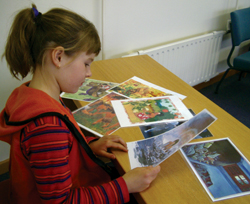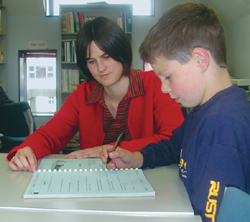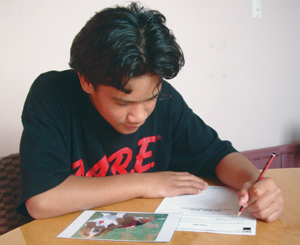New
Zealand’s National Education Monitoring Project commenced in 1993,
with the task of assessing and reporting on the achievement of New Zealand
primary school children in all areas of the school curriculum. Children
are assessed at two class levels: year 4 (halfway through primary education)
and year 8 (at the end of primary education). Different curriculum areas
and skills are assessed each year, over a four-year cycle. The main
goal of national monitoring is to provide detailed information about
what children can do so that patterns of performance can be recognised,
successes celebrated, and desirable changes to educational practices
and resources identified and implemented.
|
Each year,
small random samples of children are selected nationally, then
assessed in their own schools by teachers specially seconded and
trained for this work. Task instructions are given orally by teachers,
through video presentations, or in writing. Many of the assessment
tasks involve the children in the use of equipment and supplies.
Their responses are presented orally, by demonstration, in writing,
or through submission of other physical products. Many of the
responses are recorded on videotape for subsequent analysis.
|
|
In 2002, the fourth
year of the second cycle of national monitoring, two areas were assessed:
health and physical education, and the writing, listening and viewing
components of the English curriculum. This report presents details and
results of the assessments of students’ skills, knowledge, perceptions
and attitudes relating to writing.
Chapter
2 presents the NEMP framework for writing. It has as its central
organising theme constructing and communicating meaning in written forms
for various purposes and audiences. Within it are listed 8 understandings,
3 main purposes for writing (and 13 specific ways of achieving them)
and 16 skills, together with student attitudes toward and involvement
in writing.
Chapter
3 focuses on expressive writing, in which students were given freedom
to write inventively, within task
guidelines. Characteristics
sought included ability to write coherently, to communicate personal
feeling, to communicate stories or ideas vividly, and to follow conventions
associated with particular forms of writing.
Averaged across
50 task components administered to both year 4 and year 8 students,
21 percent more year 8 than year 4 students succeeded with these components.
Medium proportions of year 4 students and higher proportions of year
8 students followed the task guidelines quite well, but most students
were not able to achieve the clarity, vividness, personal feeling or
humour that distinguished top quality writing.
Trend analyses showed no meaningful change since 1998 for year 4 students
but a small reduction in performance for year 8 students. Averaged across
22 task components attempted by year 4 students in both years, 1 percent
more students succeeded in 2002 than in 1998. At year 8 level, again
with 22 task components included in the analysis, 5 percent fewer students
on average succeeded with the task components in 2002 than in 1998.
Chapter
4 explores functional writing. Students were asked to present information
clearly and accurately in written form. They acted as reporters, gave
instructions, prepared advertisements, filled in forms, and wrote letters,
postcards, descriptions, email messages and text messages.
Averaged across
105 task components administered to both year 4 and year 8 students,
18 percent more year 8 than year 4 students succeeded with these components.
Trend analyses showed no change since 1998 for year 8 students but a
marginal performance reduction for year 4 students arising entirely
from one of the four tasks involved. Averaged across 41 task components
attempted by year 4 students in both years, 2.5 percent fewer students
succeeded in 2002 than in 1998 (9 percent fewer on Accident
Report but 1 percent more on the other three tasks). Year 8 students
performed equally in 2002 and 1998.
Chapter
5 examines students’ performance in spelling, punctuation
and grammar, using tasks specifically designed
for this purpose. These skills were also assessed more indirectly within
some of the tasks in Chapters 3 and 4.
Averaged across 58 task components administered to both year 4 and year
8 students, 19 percent more year 8 than year 4 students succeeded with
these components. The results revealed considerable scope for improvement
in punctuation, spelling and grammar at both age levels. Trend analyses
involved only one punctuation task for year 4 students and two very
similar spelling tasks for year 8 students. This clearly is insufficient
to allow trends in the use of writing conventions to be judged adequately.
The limited evidence available shows little change between 1998 and
2002: 3 percent fewer year 4 students succeeded in 2002 than in 1998,
with no change for year 8 students.
Chapter
6 reports the results of surveys of students’ attitudes about
and involvement in writing activities, and their
perceptions of their capabilities. Students’ attitudes, interests
and liking for a subject have a strong bearing on progress and learning
outcomes.
 |
Writing
stories was the most popular writing activity for year 4 and year
8 students, both in school and in their own time, with poems and
letters also quite popular.
To be good writers, students at both levels thought that people
needed to use their imagination. Year 4 students also placed emphasis
on being willing to try things out, while year 8 students emphasized
liking writing and learning how to use punctuation. Only about 10
percent of students at both levels reported using a computer for
writing at school “heaps”, but at home this rose to
26 percent of year 4 students and 33 percent of year 8 students. |
Compared to year
4 students, fewer year 8 students were highly positive about doing writing
at school, about how good they believed themselves to be at writing,
and about how they felt their teachers and parents viewed their writing
abilities. Year 8 students also reported fewer opportunities in school
to write “things like stories, poems or letters”, and lower
enthusiasm for writing in their own time. These differences may, at
least in part, reflect the well-known tendency of students to get more
jaded about schoolwork as they get older. Such patterns have been found
repeatedly in our other national monitoring surveys. Another influential
factor may be that the emphasis on various types of writing tasks shifts
between year 4 and year 8, with more creative opportunities at year
4 and substantial volumes of more formal writing required by year 8.
Chapter
7 reports the results of analyses that compared the performance
of different demographic subgroups. School type (full primary or intermediate),
school size, community size or geographic zone did not seem to be important
factors predicting achievement on the writing tasks, or attitudes to
writing. Non-Mäori students outperformed Mäori students on
about thirty-five percent of the tasks at both year levels. There were
statistically significant differences in the performance of students
from low, medium and high decile schools on 72 percent of the year 4
tasks and 83 percent of the year 8 tasks. The most startling result,
however, involved the comparison of results for boys and girls. Girls
performed better than boys on 39 percent of the year 4 tasks, but on
88 percent of the year 8 tasks. At both levels, girls also displayed
more positive attitudes to writing.
| Between
1998 and 2002, there have been noticeable changes in subgroup differences
for three of the seven variables. The only variable showing a change
for year 8 students was the SES index (based on school decile),
with the percentage of tasks showing performance differences increasing
from 72 percent in 1998 to 83 percent in 2002. For year 4 students,
however, three variables showed reduced disparity in 2002. The percentage
of tasks on which year 4 Mäori students scored lower than non-Mäori
students decreased from 46 percent in 1998 to 36 percent in 2002.
Similarly, the percentage of tasks on which year 4 students from
low SES (decile) schools scored lower than students from high SES
schools decreased from 83 percent to 72 percent. The most dramatic
change involved the percentage of tasks on which year 4 girls performed
better than boys, which decreased from 79 percent in 1998 to 39
percent in 2002. |
|
Chapter
8 reports
the results of analyses of the achievement of Pacific Island students.
Additional sampling of schools with high proportions of Pacific Island
students permitted comparison of the achievement of Pacific Island,
Mäori and other children attending schools that have more than
15 percent Pacific Island students enrolled. The results apply only
to such schools, but it should be noted about 75 percent of all Pacific
students attend schools in this category.
Compared to Mäori and “other” students in these schools,
year 4 Pacific students performed less well than the “other”
students on 25 percent of the tasks but similarly to Mäori students.
The results for year 8 students were very similar.
|





